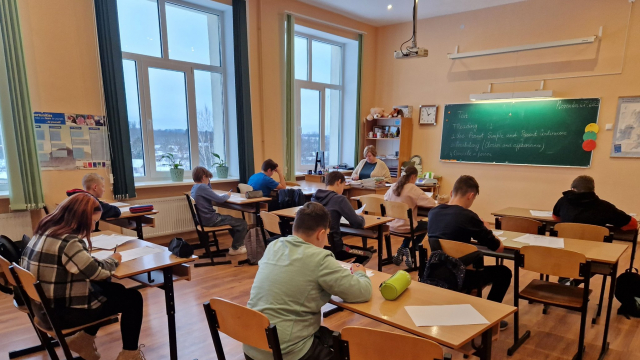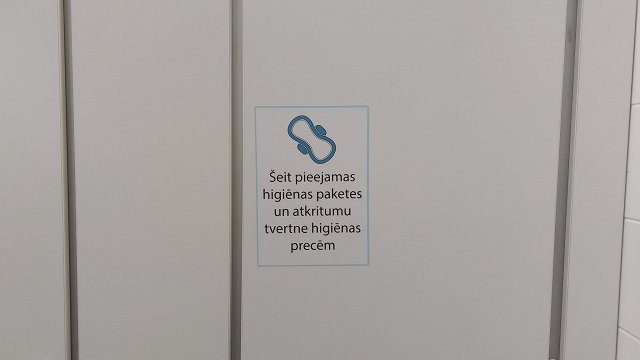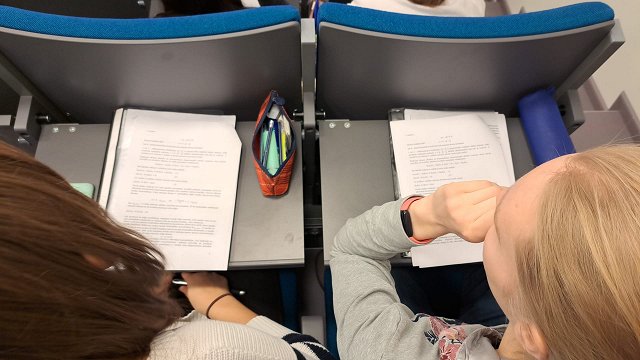Over ten years, the number of students of vocational basic and secondary education institutions has decreased by 11.1 %, or 3,448 students. However, as the demand for digital skills has increased, enrolment in science, mathematics and computing programs is rising.
Number of entrants increased slightly
In the school year 2023 the number of entrants in vocational education programs accounted for 10.9 thousand students, which is 3.3 % or 347 students more than in the previous period.
As in previous years, the share of male entrants exceeded that of females – 55.0 % or 6 039 of all entrants were men and 45.0 % or 4 936 were women. Engineering, manufacturing and construction (entered by 4.2 thousand students or 38.2 % of all students) as well as services (2.3 thousand students or 21.0 %) were the most popular fields of education.
During the last ten years, there have been changes in the labor market, which are reflected in the choice of vocational education programs. Compared to 2013, the share of students has increased in science, mathematics and computing programs (4.5 percentage points), humanities and arts (4.2 percentage points) and agriculture (3 percentage points) programs. In turn, the largest drop in the share of entrants was in broad group services (6.1 percentage points) and in social sciences, business and law (4.7 percentage points) programs.
Compared to the previous year, the rise in the number of entrants took place in broad group services (219 students or 10.5 %), humanities and arts (124 or 9.5 %) and engineering, manufacturing and construction (128 or 3.1 %) programs. The most significant downturn in the number of entrants was in social sciences, business and law (78 students or 9.5 %) and health and social welfare (25 or 3.7 %) programs.
Within the engineering, manufacturing and construction programmes, engineering and engineering trades (26.1 %), building and civil engineering (22.1 %), as well as mechanics and metal work (15.3 %) were the most popular programs. Within the services field, the greatest number of entrants was recorded in the programs of hotel, restaurant and catering (59.4 %) and hair and beauty services (21.2 %).
The highest proportion of women entered health and social welfare (94.0 %) as well as social sciences, business and law (77.2 %) programmes. The highest of share of men, in turn, entered science, mathematics and computing (88.1 %) as well as engineering, manufacturing and construction (81.1 %) programs.
The mean age of the entrants was 19.4 years. The bulk of students (84.2 %) are aged under 20, 6.6 % – from 21 to 30, and 2.3 % are aged over 50.
The highest vocational education enrolment year after year is recorded in engineering, manufacturing and construction (9.8 thousand or 35.5 % of all students) as well as services (5.8 thousand or 20.9 %) programs. The lowest enrolment, in turn, is observed in health and welfare (818 students or 3.0 %) as well as agriculture (1.5 thousand students or 5.3 %) programs.
Compared to the year before, significant enrolment downturn is observed in services programs (of 364 or 5.9 %) as well as social sciences, business and law (41 or 1.9 %). The largest upturn is in science, mathematics and computing programs – 155 students or 5.0 % and in health and social welfare programs – 22 or 2.8 %.
Digital skills are increasingly in demand in today's labor market – compared to 2013, the number of students in science, mathematics and computing programs has increased by 76.0 % or 1 402 students. Almost equally large rise was in agriculture programs – 75.7 % or 629 students. Social sciences, business and law programs are becoming significantly less popular, where the number of students has decreased by 50.8 % or 2 158 students. Since 2013, services programs have also decreased – the number of students has reduced by 25.6 % or 1 989 students.
Out of all students, 91.1 % or 25.1 thousand enrolled in vocational secondary education programs, 8.6 % or 2.4 thousand in post-secondary (non-tertiary) programs, and 0.3 % in basic education programs.
Men constitute majority of the vocational education students (15.6 thousand or 56.6 %) while women account for 11.9 thousand or 43.4 %. Compared to the previous year, the share of women in vocational education has increased by 0.3 percentage points. The lowest share of women was in 2010 with 39.8 %, and it has increased since then.
More than a half (52.5 % or 8.2 thousand) of men is studying engineering, manufacturing and construction, followed by science, mathematics and computing (18.8 % or 2.9 thousand). Only 44 or 0.3 % of the total number of men in vocational education study health and social welfare programs. Women more commonly (31.9% or 3.8 thousand) enrol in services programs (mainly hotel, restaurants and beauty services). More than one fourth of women (27.7 % or 3.3 thousand) have chosen humanities and arts, while 13.9% or 1.7 thousand social sciences, business and law and engineering, manufacturing and construction 13.3 % or 1.6 thousand.
The smallest number of graduates in the past 20 years
In the school year 2023 the number of entrants in vocational education programs accounted for 5.9 thousand students, which is 2.0 % or 120 students less than in 2022. Last year the number of graduates was the lowest in the past 20 years – compared to 2003, the number of graduates has dropped by 53.0 %. More than a half (52.3 %) or 3.1 thousand of graduates were men. As in 2022, a third (33.0 %) or 1.9 thousand obtained qualifications in engineering, manufacturing and construction, while 1.4 thousand or 23.4 % in services.
In the school year 2023/2024, 53 educational institutions (41 vocational education institutions, 10 colleges and 2 secondary schools) offer professional education programs. Compared to the previous school year, the number of professional education institutions has decreased due to reorganization – Rēzekne Music Secondary School and Rezekne Art and Design Secondary School were merged.
Almost one third or 34.5 % of the enrolments have entered six of the largest education institutions: Riga State Technical School, Riga Technical School of Tourism and Creative Industry, Ogre Technical School, Latgale Industrial Technical School, Riga Technical College and Liepaja State Technical School. Only in seven vocational education institutions the number of students exceeds one thousand, in 22 institutions it is over five hundred and in 18 institutions no more than two hundred.



























